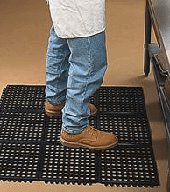Sunday Spotlight: Anti-Fatigue Matting
For people that work at stationary workstations for the majority of their day, anti-fatigue matting is an indispensible material that saves many from sore feet, legs, and backs. It does this by replacing the hard floor beneath with a mat comprised of a softer, more compressible material, such as rubber. This allows the tremendous forces expressed by the operator's body to be absorbed by the matting, rather than it being reflected back at the operator's feet. The mat deforms under pressure from the body, greatly reducing fatigue caused by prolonged exposure to a hard floor.
The mat also encourages blood flow in the legs, as the softness of the mat causes minute muscular contractions resulting from slight movements that would not otherwise happen on a harder surface. This allows improved transport of nutrients and waste to and from the legs, thereby reducing the buildup of lactic acid, a compound that is partly repsonsible for pain in the legs after a long shift of static standing.
Also, be sure to inspect any anti-fatigue matting that you may have on a regular basis. Matting that has gone hard from prolonged use will be less effective than a newer mat, and older mats may curl at the edges, creating a tripping hazard.
While jobs should be designed to incorporate as much movement as possible, the hazards of static standing are often unavoidable. The anti-fatigue mat does much to migtigate those risks; henceforth, no standing workstation should be deprived of its benefits.


0 Comments:
Post a Comment
Subscribe to Post Comments [Atom]
<< Home